
Filippo Balbi (1806 - 27 September 1890) was an Italian painter, active in an archaic style depicting allegoric and religious scenes.

Filippo Balbi (1806 - 27 September 1890) was an Italian painter, active in an archaic style depicting allegoric and religious scenes.
Filippo was born in Naples, and studied in the Academy of Fine Arts of his native city, but moved to Rome.
In 1844, one of his first commissions was for a Madonna della Cintura for the Convent of the Madonna della Neve in Frosinone. In 1854, he began to paint a ceiling for the Certosa di Trisulti located in Collepardo, province of Frosinone.
Much of his life's output after 1859 was for the Certosa, including canvases for the church, lunettes, and eclectic frescoes for the pharmacy. He also painted a Testa anatomica (1854), located now in the Museo di Storia della Medicina of the Sapienza University of Rome in Rome.
He painted an Immaculate Conception (1877) for the Church of the Consolazione in Collepardo, now on display in a chapel of the parish church of Santissimi Salvatore.
Filippo died in Alatri in 1890. [1]

Filippino Lippi was an Italian painter working in Florence, Italy during the later years of the Early Renaissance and first few years of the High Renaissance.

Pietro Perugino, born Pietro Vannucci, was an Italian Renaissance painter of the Umbrian school, who developed some of the qualities that found classic expression in the High Renaissance. Raphael was his most famous pupil.
Frosinone is a town and comune in Lazio, central Italy, the administrative seat of the province of Frosinone. It is located about 75 kilometres (47 mi) south-east of Rome close to the Rome-Naples A1 Motorway. The city is the main city of the Valle Latina, an Italian geographical and historical region that extends from south of Rome to Cassino. Until the nineteenth century it was a village with a rural vocation, while from the twentieth century it became an important industrial and commercial center. Traditionally considered a Volscian city, with the name of Frusna and then the Roman of Latium adiectum as Frùsino, over the course of its millenary history it has been subjected to multiple devastations and plunders caused by its geostrategic position; as a consequence of this, as well as due to the destruction due to seismic events, it retains only rare, albeit significant, traces of its past.

Alatri is an Italian town and comune of the province of Frosinone in the region of Lazio, with c. 30,000 inhabitants. An ancient city of the Hernici, it is known for its megalithic acropolis.
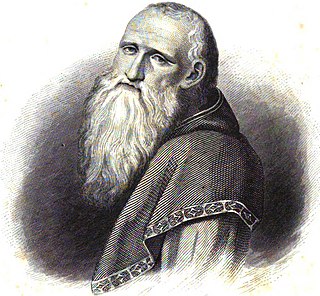
Bernardino Luini was a north Italian painter from Leonardo's circle during the High Renaissance. Both Luini and Giovanni Antonio Boltraffio were said to have worked with Leonardo directly; he was described as having taken "as much from Leonardo as his native roots enabled him to comprehend". Consequently, many of his works were attributed to Leonardo. He was known especially for his graceful female figures with elongated eyes, called Luinesque by Vladimir Nabokov.
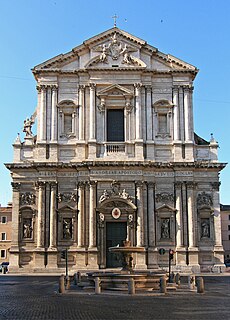
Sant'Andrea della Valle is a minor basilica in the rione of Sant'Eustachio of the city of Rome, Italy. The basilica is the general seat for the religious order of the Theatines. It is located at Piazza Vidoni, at the intersection of Corso Vittorio Emanuele and Corso Rinascimento.

Livio Agresti (1508–1580), also called Ritius or Ricciutello, was an Italian painter of the late Renaissance or Mannerist period, active both in his native city of Forlì and in Rome, where he died. He was one of the members of the "Forlì painting school".
Bernardo Castello (1557–1629) was an Italian painter of the late-Mannerist style, active mainly in Genoa and Liguria. He is mainly known as a portrait and historical painter.

San Martino ai Monti, officially known as Santi Silvestro e Martino ai Monti, is a minor basilica in Rome, Italy, in the Rione Monti neighbourhood. It is located near the edge of the Parco del Colle Oppio, near the corner of Via Equizia and Viale del Monte Oppio, about five to six blocks south of Santa Maria Maggiore.
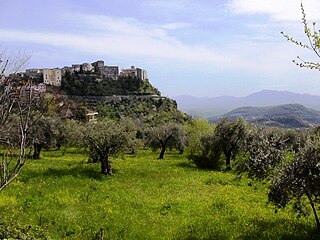
Veroli is a town and comune in the province of Frosinone, Lazio, central Italy, in the Latin Valley.

The Certosa di Pavia is a monastery and complex in Lombardy, Northern Italy, situated near a small town of the same name in the Province of Pavia, 8 km (5.0 mi) north of Pavia. Built in 1396–1495, it was once located on the border of a large hunting park belonging to the Visconti family of Milan, of which today only scattered parts remain. It is one of the largest monasteries in Italy.

Collepardo is a comune (municipality) in the Province of Frosinone in the Italian region Lazio, located about 70 kilometres (43 mi) east of Rome and about 15 kilometres (9 mi) north of Frosinone.

Esperia is a comune (municipality) in the Province of Frosinone in the Italian region Lazio, located about 110 kilometres (68 mi) southeast of Rome and about 40 kilometres (25 mi) southeast of Frosinone. It is located within the Monti Aurunci Natural Park.

Pier Francesco Mazzucchelli was an Italian painter and draughtsman who was active in Milan. He is mainly known for his altarpieces, but his outstanding achievements are large decorative frescoes for the Sacro Monte di Varese and the Sacro Monte di Varallo.
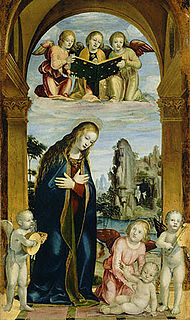
BernardoZenale was an Italian painter and architect.
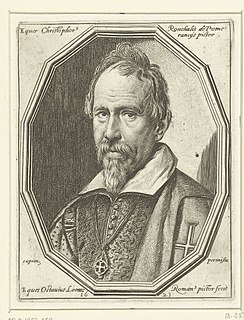
Cristoforo Roncalli was an Italian mannerist painter. He was one of the three painters known as Pomarancio or Il Pomarancio.
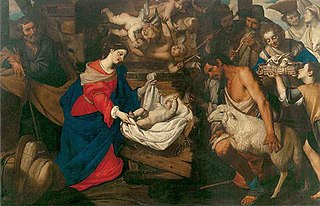
Pacecco De Rosa was an Italian painter, active in Naples.
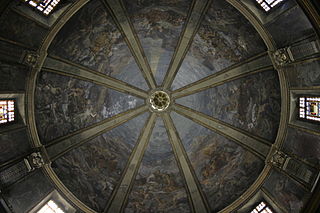
Agostino Comerio was an Italian painter, active mainly in Northern Italy.

Pompeo Marino Molmenti was an Italian painter.

Trisulti Charterhouse is a former Carthusian monastery or charterhouse, now owned by the Cistercians, in Collepardo, province of Frosinone, central Italy. It is located on the slopes of Monte Rotonaria, a peak of the Monti Ernici, at 825 meters above sea level. It was consecrated in 1211, becoming a national monument in 1873.